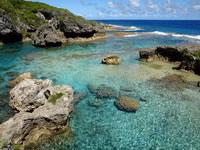Niue: Using integrated land use, water supply and wastewater management as a protection model for the Alofi town groundwater supply and nearshore reef fishery (site 2)
Aims: To protect the Alofi groundwater, well field and near shore area from over-abstraction and land-based pollution through an IWRM framework
Activities: Improving management of hazardous waste, solid waste, wastewater to reduce run-off from industries, fisheries processing, agriculture and roads; Awareness raising and planning for water conservation and demand management; Establishment of groundwater protection zones; Hydrogeological and water quality surveys for maintenance of well field; Water policy and planning.
"3(b) INDICATOR#2: WATER CONSERVATION AND DEMAND MANGEMENT MEASURES
Target: 20% increase in Alofi storage
Prior to the GEF Pacific IWRM Project, Alofi’s supply relied on a heavily leaking 325 m3 tank, providing only about wo days water supply storage for the Alofi community, meaning that he community was particularly vulnerable to groundwater pollution or pump failure. The project has seen the replacement of the existing tank with two new 240 m3 storages, increasing storage by over 45% and significantly increasing supply security by eliminating storage leakage loses."
"2. RESULTS: PROCESS
Despite significant groundwater resources, Niue’s governance framework for water management prior to the project needed updating as water resource and sanitation management was not coordinated, had minimal engagement across sectors and key stakeholders and the groundwater resource was not adequately protected. Through the project and with support of the EU IWRM partner project, legislation has ben updated to provide the governance framework; national and district coordination bodies have ben developed to provide direction and direct engagement for the community, government sectors and other stakeholders in water management decisions and national and village water safety plans have ben endorsed and are currently being implemented.
2(a) INDICATOR#1: REVISED LEGISLATION PROTECTING WATER
Target: Enactment of the Niue Water Bil 2012
The lack of regulations suporting water protection and water use eficiency meant hat here were very
limited options for managing potential impacts on the main drinking water resources in Niue, the
groundwater lens. Aditonaly, the existing legislative framework did not suport integration of water
resources management in Niue, with individual Ministry responsibilties linked to specifc legislation.
The enactment of the Niue Water Act 2012 has provided the framework for regulations to adres
concerns relating to water use eficiency, alocation and protection of drinking water resources.
Aditonaly, it provides for the development of a national Water Resource Management Plan and
integration of water and sanitation management acros government and other stakeholders,
administering the Act in an integrated aproach acros thre separate agencies.
2(b) INDICATOR#2: VILLAGE WATERS MANAGEMENT PLANS FOR ALOFI NORTH AND ALOFI
SOUTH VILLAGE COMMUNITIES IMPLEMENTED
Target: “Community to Cabinet” Vilage Water Management Plans Endorsed by Cabinet and Audited
Prior to the GEF IWRM project, water management in Niue was broadly considered the responsibilty of
government, with very litle community engagement. Household water use rates were amongst he
highest in the world, reflecting a lack of understanding and ownership of water resource management.
Under the project, Vilage Waters Management Plans were developed to engage communites in water
management, to strengthen communications on key water isues and to foster a sense of ownership.
The development of Vilage Water Management Plans in both Alofi South and Alofi North has also
provided a mechanism for the community to communicate with its national partners including the
Cabinet Ministers, as wel as diferent groups within vilage communites. Important developments as
part of this proces have included gender mainstreaming and the increased capacity of communites to
suport he implementation of drinking water safety plans. This in turn has contributed to a measured
reduction in household water use.
2(b) INDICATOR#2: VILLAGE WATERS MANAGEMENT PLANS FOR ALOFI NORTH AND ALOFI
SOUTH VILLAGE COMMUNITIES IMPLEMENTED
Target: “Community to Cabinet” Vilage Water Management Plans Endorsed by Cabinet and Audited
Prior to the GEF IWRM project, water management in Niue was broadly considered the responsibilty of
government, with very litle community engagement. Household water use rates were amongst he
highest in the world, reflecting a lack of understanding and ownership of water resource management.
Under the project, Vilage Waters Management Plans were developed to engage communites in water
management, to strengthen communications on key water isues and to foster a sense of ownership.
The development of Vilage Water Management Plans in both Alofi South and Alofi North has also
provided a mechanism for the community to communicate with its national partners including the
Cabinet Ministers, as wel as diferent groups within vilage communites. Important developments as
part of this proces have included gender mainstreaming and the increased capacity of communites to
suport he implementation of drinking water safety plans. This in turn has contributed to a measured
reduction in household water use."
| Photo | |
|---|---|
 |
|
| Data | |
|---|---|
| Year | 2012 |
| Reporting date | 14-Mar |
| Related sites |
|---|
|
Ridge to reef: protecting water quality from source to sea in the Federated States of Micronesia
Improved catchment management
Environmental and socio-economic protection in Fiji: Integrated flood risk management in the Nadi River Basin (site 2)
Improved catchment management
Tonga: Improvement and Sustainable Management of Neiafu; Vava’u’s Groundwater Resource
Pollution Reduction to Aquifers: N
Integrated Sustainable Wastewater Management (Ecosan) for Tuvalu
Municipal Wastewater Pollution: N
Integrated Sustainable Wastewater Management (Ecosan) for Tuvalu (site 2)
Water Use Efficiency
Integrated Sustainable Wastewater Management (Ecosan) for Tuvalu (site 3)
Water Use Efficiency
Vanuatu: Sustainable Management of Sarakata Watershed (site 2)
Improved catchment management |

























